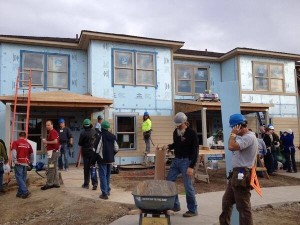Exterior Wall Insulation
 Exterior wall insulation using Dow Styrofoam extruded polystyrene boards will considerably reduce energy loss through external walls of new and existing buildings.
Exterior wall insulation using Dow Styrofoam extruded polystyrene boards will considerably reduce energy loss through external walls of new and existing buildings.
Exterior wall insulation provides a good substrate for any finishing jobs such as plastering, dry ling and rendering.
External walls should be insulated to reduce radiant, conducted and converted heat transfer.
Exterior wall insulation can be installed:
• within cavities
• within stud frames
• on the outside of stud frames
• on the inside or outside of solid walls.
Adding insulation to existing buildings can greatly increase comfort and reduce energy costs which in turn reduces greenhouse gas emissions. An ideal time for doing this is during renovations. Insulation can be retrofitted to various
construction types.Single skin high mass walls such as concrete block, rammed earth or mud brick can have their thermal performance significantly improved by installing insulation on the wall exterior. The simplest method is to use
extruded polystyrene board with an external render.
Advantages for the use of Excluded Polystyrene:
• Rigid boards that retain air but exclude water
• High R-value per unit thickness,suitable where space is limited
• Easy to cut and install; can be rendered
• Greater structural strength and moisture resistance than expanded polystyrene
• Superior noise reduction means a more quiet, comfortable interior space
• Solid, edge-to-edge construction helps eliminate pest infiltration
• Properly constructed homes built with insulated concrete can offer superior performance under anticipated elements of nature, such as rodents, insects, fire, hail, high winds and
Adding external wall insulation after construction:
Walls and skillion roofs are the hardest to insulate after construction, as the internal or external lining must be removed. A good time to insulate walls is during re-cladding or re-plastering. Specialized products are available to insulate existing walls: check with your local building information center.

